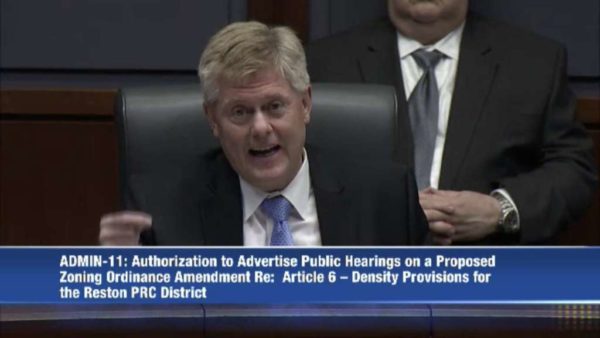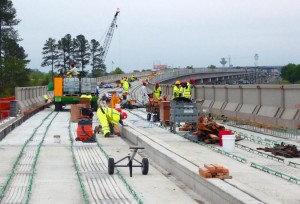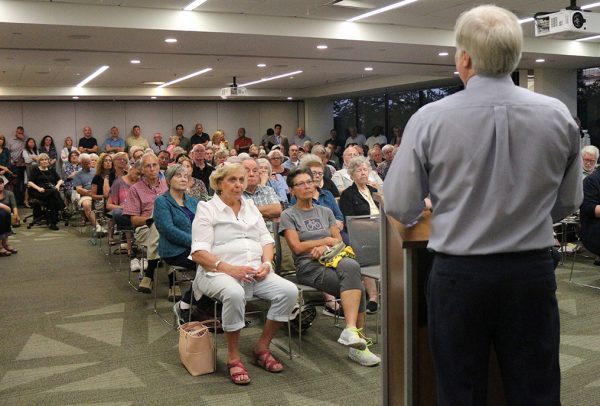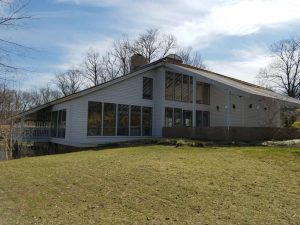Fairfax County’s Board of Supervisors disagreed about community input on contentious proposed zoning changes, before authorizing public hearings early next year on the changes at their meeting today.
The proposal, which would increase the population density in Reston, has sparked a backlash from community groups, including the Reston Association, Coalition for a Planned Reston and Reston 2020.
County planning officials have argued that the change is needed to put into action Reston’s Master Plan, which allows for future growth over the next 40 years.
Dranesville District Supervisor John Foust vented frustration at the Dec. 4 meeting that Reston residents have not heard back from the county regarding the public hearings for the zoning proposal.
In response to Foust’s concerns, Hunter Mill District Supervisor Cathy Hudgins said that locals have had plenty of opportunities to get the desired information.
County officials began small workgroup sessions hosted by the Coalition for a Planned Reston, a grassroots organization, and the Reston Association in July to discuss the controversial plan.
“Yes, there are some questions that people have,” Hudgins said. “Those questions have been answered before or are not relevant to this.”
Hudgins stressed that consideration of the proposed zoning changes is moving forward because of the work, including 13 follow up meetings since May and regular meetings with the Reston Association, already done.
Hudgins praised the “noble” staff for answering community questions.
Braddock District Supervisor John Cook said that verbal responses from staff to locals are not enough, adding that the community would benefit from written questions and answers available online.
“I don’t think it’s enough to have oral questions,” Cook said. “Not everyone can get to public meetings.”
Cook added that community input must have limits. “It’s fair to have a cut off date for questions,” he said.
The Fairfax County Planning Commission has 100 days from the referral — the staff report published Dec. 4 — to take action on the zoning proposal. The Board of Supervisors authorized public hearings on the zoning changes for 7:30 p.m. on Jan. 23 and at 4:30 p.m. on March 5.
“The clock starts today,” Lee District Supervisor Jeff McKay said.
.@johnfoustva venting frustration that Reston residents not hearing back from @fairfaxcounty when it comes to advertising public hearings for zoning ordinances. To which the Dept. of Planning/Zoning places blame on Reston—never guaranteed response to every inquiry. Wow, not good! pic.twitter.com/bAcnJ3jtPh
— Fairfax County Memes (@FairfaxMemes) December 4, 2018
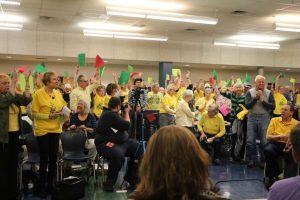 Opponents of a proposal before the county to increase Reston’s population density continue to mobilize ahead of community meeting on Monday night.
Opponents of a proposal before the county to increase Reston’s population density continue to mobilize ahead of community meeting on Monday night.
The Coalition for a Planned Reston, a community organization that includes Reclaim Reston, Reston 20/20 and the Reston Citizens Association, will gather community feedback about the proposal and discuss specific changes to scale back Reston’s master plan in an effort limit the scale of development in the planned community.
The proposal, which will go before the county’s Board of Supervisors, would increase the maximum allowed population per acre in the Planned Residential Community district from 13 persons up to 16.
The zoning change could also open up Reston’s village centers to increased residential development. The proposal would allow the Board of Supervisors to approve developments above 50 residential units per acre within the district’s Transit Station Areas (TSAs) — so long as the projects comply with the area’s master plan that guides development.
Reston Association staff opposed the changes. In a letter, In the letter, the RA staff also asks county supervisors to hold off on any further consideration of the PRC density cap increase until RA staff and county staff together can examine the Reston Master Plan portion of the county’s Comprehensive Plan.
Meanwhile, the coalition will pitch amendments to Hunter Mill District Supervisor Cathy Hudgins before Christmas. Overall, the coalition is seeking to constrain density growth and ensure infrastructure keeps up to pace with development.
CPR hopes to maintain the intensity of opposition to the proposal, which eclipsed in late October during a 900-person public community meeting in Reston where an overwhelming majority of attendees opposed the proposal.
“We are anxious to present what we believe are reasonable Reston plan amendments to Supervisor Hudgins rather than just denoting a list of topic areas where changes could be made,” said Terry Maynard, co-chair of the Reston 20/20 Committee. “We are hopeful that the community will buy in to these proposals and possibly suggest some modifications and additions.”
Changes under consideration include reinstating a population cap throughout Reston which existed in the community’s 1989 plan; placing a cap on high-density, high-rise residential development, which the coalition stated is unlimited in the current plan; and phasing development with supporting infrastructure similar to the Tysons plan.
On a broader level, the coalition seeks to ensure county policies and standards that govern schools, parks and transportation are realistically in line with Reston’s growth potential.
CPR will also use the meeting platform to discuss other controversial zoning matters, including the “densification of Saint Johns Woods” and the addition of a road through Hidden Creek Country Club.
“The last minute inclusion by the Planning Commission of developer language allowing Bozzuto to re-develop St. Johns Woods at triple its current density is a perfect example of community exclusion in the development process,” said Reclaim Reston member Bruce Ramo.
The meeting will be held on Monday at 7 p.m. in the Reston Association Conference Center.
A zoning change to allow for more development and accommodate population growth was discussed during The Kojo Nnamdi show Wednesday — a conversation that painted the ongoing issue as a microcosm of a perennial debate on how to manage development, growth and public infrastructure.
Leslie Johnson, zoning administrator for Fairfax County, said the zoning change, which would increase the population density per acre from 13 to 16, along with a host of other changes that implement the Reston Master Plan, a planning document that lays out the vision for the area, said Fairfax County officials are working hard to ensure development matches the pace of public infrastructure.
She also noted the county is aware of the need to preserve already stable residential neighborhoods that surround areas along the Metro that are targeted for growth.
“We can’t stop development waiting for the roads to be built,” Johnson said, adding that the county recently developed a funding plan for road infrastructure and developers are helping in tandem.
Johnson noted that the zoning change was consistent with master plans adopted in 2014 and 2015. She also said she was encouraged by vehement opposition that surfaced in two community meetings earlier this year.
“It’s a good sign that people are engaged because we get criticized for not engaging enough. I think peoples’ voices need to be heard,” she said.
Nimbyism is not the rallying point for people opposed to the zoning change, according to some residents.
Terry Maynard, co-chair of Reston 20/20, a citizen activist group that is against the proposal, said many people are opposed to the scope of development, not development itself.
Absent adequate public infrastructure for current residents, allowing more population density in pockets in Reston damages residents’ quality of life. He also noted projections about population increases as a result of the zoning change do not account for growth from affordable housing units and bonus density allowed for some developments.
“The Reston Master plan is very weak in defining infrastructure needs for the community in sharp contrast for a similarly-prepared plan for the Tysons area,” he said.
The cart-before-the-house argument has been echoed in community meetings.
But, to some extent, the zoning change is an exercise in how open communities are to change, especially as the county is in “a state of transition” in anticipation of Metro, which the county has been preparing for for the last 20 years, Johnson said.
Amendments to the zoning change are expected. The county is leaving the board with the flexibility to determine what population density between 13 and 16 per acre is most feasible, she said. Johnson also said the county was open to changing the maximum number of residential units allowed per acre.
A round of public hearings are expected to begin early next year.
Virginia, unlike Maryland, is a conditional zoning state, which means it lacks the Adequate Public Facilities Ordinance, a mechanism that attempts to manage growth by ensuring adequate roads, schools and public facilities are in place as development occurs. APFO laws vary by state and county.
A complete recording of the show is available online.
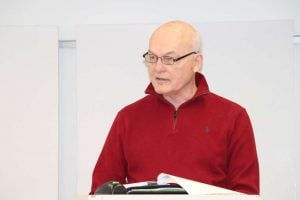 This is an op/ed submitted by Terry Maynard, co-chair of the Reston 20/20 committee. It does not reflect the opinions of Reston Now.
This is an op/ed submitted by Terry Maynard, co-chair of the Reston 20/20 committee. It does not reflect the opinions of Reston Now.
The County, via its proposed zoning density increases, and developers are already planning for Reston’s Village Centers to become nearly two to three times as densely populated as Arlington County’s major Ballston Transit Station Area (TSA).
The result is astounding given that Ballston is rightly a high-density mixed-use transit-oriented development area served by two Metro lines while Reston’s Village Centers are nowhere near Metro. Moreover, the recent year-long Reston transportation development effort (RNAG) revealed that Fairfax County explicitly doesn’t plan to enhance local bus transit to serve the Village Centers or our TSAs.
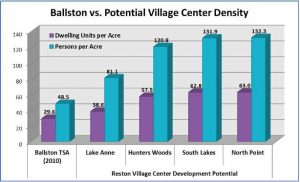 Fairfax County data and US Census 2010 data for Ballston show that, with the exception of Lake Anne Village Center, where a redevelopment plan is already in place, the number of dwelling units (homes) per acre will potentially be at least twice as dense as in Ballston. Moreover, because Fairfax County anticipates a fraction more people in each household, the potential number of residents per acre runs better than two and one-half times that experienced in Ballston.
Fairfax County data and US Census 2010 data for Ballston show that, with the exception of Lake Anne Village Center, where a redevelopment plan is already in place, the number of dwelling units (homes) per acre will potentially be at least twice as dense as in Ballston. Moreover, because Fairfax County anticipates a fraction more people in each household, the potential number of residents per acre runs better than two and one-half times that experienced in Ballston.
At the risk of repeating ourselves, Reston’s Village Centers are intended to be neighborhood-serving gathering places. They are not meant to be transit station areas without the “transit.” According to US Census data, Ballston is the most populous area in Arlington County and the fourth most densely populated (people per acre). The notion that TSA residential densities should be applied in Reston’s Village Centers is preposterous and contradicts everything that the Reston Master Plan says about their development.
The current Reston Master Plan calls for the following in any Village Center redevelopment: “Enhance Village Centers as vibrant neighborhood gathering places; advance excellence in site design and architecture; strengthen connectivity and mobility; [and] protect and respect the surrounding residential neighborhoods.”
Any notion that residential density in excess of 100 people per acre is consistent with these objectives is ludicrous.
If you don’t want your neighborhood Village Center to be blown up and replaced with one or more 12- to 14-story high-rise apartments or condos, please come to the community meeting on the Reston PRC zoning ordinance on Monday at South Lakes High School. Bring your friends and your children for a major civics lesson on local government. Learn, question, and challenge what you hear. It is our Reston and we must act to protect it by showing our revulsion with this absurd zoning ordinance proposal.
Terry Maynard, Co-Chair
Reston 20/20 Committee
 This is an op/ed submitted by Terry Maynard, co-chair of the Reston 20/20 committee. It does not reflect the opinions of Reston Now.
This is an op/ed submitted by Terry Maynard, co-chair of the Reston 20/20 committee. It does not reflect the opinions of Reston Now.
Restonians turned out in droves two weeks ago for a County-organized community meeting on its proposed Reston PRC zoning ordinance amendment. The essence of the proposed language change is to increase the cap on Reston’s population from 13 to 16 people per acre, but that ignores several other factors including station area development, affordable housing and “bonus” market rate housing for developers. The crowd was so large that Supervisor Hudgins was forced to cancel the meeting. Those hundreds of people were there because, contrary to what the County keeps telling the community, the proposed zoning change opens the door for an overall tripling of Reston’s population.
But that is only part of the story.
An important element of the zoning amendment proposal is the residential development it would not only allow, but is already planned, in our Village Centers. The Village Centers–North Point, Lake Anne, South Lakes, and Hunters Woods–are currently our neighborhood shopping centers and intended to be “neighborhood gathering places” in Bob Simon’s vision. They are where we buy our groceries, purchase our prescriptions, dine out in locally-owned restaurants, and meet many of our other family needs.
Here is what the Reston Master Plan has to say about the role of our Village Centers:
The general vision for Reston’s Village Centers addresses the fundamental elements necessary for any Village Center to achieve the desired goal of becoming a vibrant community gathering space. The Village Center general vision is an elaboration of the Reston Vision and Planning Principles. Recognizing that each Village Center faces unique circumstances, redevelopment proposals should take advantage of this to creatively interpret the general vision to provide a unique, vibrant community gathering space:
• Enhance Village Centers as vibrant neighborhood gathering places.
• Advance excellence in site design and architecture.
• Strengthen connectivity and mobility.
• Protect and respect the surrounding residential neighborhoods. . . .(The) Central Public Plaza should (h)ighlight the Village Centers as neighborhood scale gathering places, in contrast to the regional scale gathering places in the Town Center or the community scale gathering places in the other TSAs.
In short, our Village Centers are meant to be our hyper-local “gathering places” to live, work, and play with our families, friends, and neighbors. Nothing in the whole section of the Comprehensive Plan on Reston’s Village Centers suggests they should be anything other than neighborhood serving and, indeed, the plan suggests the opposite.
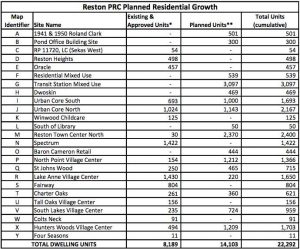 But that is not what the proposed Reston PRC zoning ordinance would allow and, indeed, what is already being planned according to the County’s data. The county’s table of proposed redevelopment sites, which provides the county’s justification for raising the population cap, projects huge increases in dwelling units and population that are totally out of character and will overwhelm North and South Reston.
But that is not what the proposed Reston PRC zoning ordinance would allow and, indeed, what is already being planned according to the County’s data. The county’s table of proposed redevelopment sites, which provides the county’s justification for raising the population cap, projects huge increases in dwelling units and population that are totally out of character and will overwhelm North and South Reston.
Approval of the PRC zoning amendment to raise the population cap to accommodate such growth will allow developers to add nearly 13,000 residents to our Village Centers, including new affordable and bonus market rate housing that could be added under the county’s rules but is not included in the county’s table. In the worst case example, North Point Village Center, the PRC re-zoning proposal shows a potential twelve-fold increase in dwelling units (DUs), an increase of nearly 1,700 DUs and 3,600 residents. At the low end of the spectrum is Lake Anne Village Center whose redevelopment plan has already been approved with a near tripling of the number of residents to more than 2,600. Across Reston’s four Village Centers, population would be allowed to nearly quintuple.
(This article was updated at 9 a.m. Friday, Oct. 6, to add official information about the cafeteria’s occupancy limit.)
After being postponed last month because of a huge turnout at Lake Anne Elementary School, the next public meeting on a proposed Fairfax County zoning ordinance amendment for Reston’s Planned Residential Community (PRC) district has been rescheduled.
The meeting is slated for Monday, Oct. 23, at 7 p.m. in the cafeteria at South Lakes High School (11400 South Lakes Drive).
The Sept. 25 meeting at the LAES elementary school was called off after a large number of people — estimated at more than 400 — showed up to oppose the plan. It was to be the fourth public meeting on the proposal, which would bump the overall limit on people per acre in Reston’s Planned Residential Community (PRC) District from 13 to 16. (The density is currently about 11.9 people per acre.)
The PRC District does not include any of the fast-growing Transit Station Area property surrounding the Wiehle-Reston East and Herndon Metro stations, nor does it include most of the property in the Reston Town Center Metro station TSA south of the Dulles Toll Road.
The ordinance amendment would also allow for the Board of Supervisors to be able to approve individual developments in excess of 50 dwelling units per acre in TSAs within the PRC and when in accordance with Comprehensive Plan recommendations. Those areas that would be marked for possible major residential development include all of Reston’s village centers.
Citizen activists warn that the combined effect of these changes could see the population of Reston tripled by 2050.
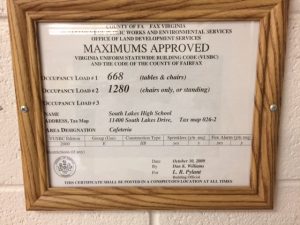 The occupancy limit for the SLHS cafeteria is 668 when tables are present, though it can hold up to 1,280 if the several dozen large tables are removed.
The occupancy limit for the SLHS cafeteria is 668 when tables are present, though it can hold up to 1,280 if the several dozen large tables are removed.
The SLHS activities office said Supervisor Cathy Hudgins’ office requested a space that would be able to accommodate around 650 people. The school’s auditorium was unavailable for the meeting, the activities office said, because of scheduled theater rehearsals. That space has fewer than 600 seats anyway, according to SLHS officials.
The school’s gym also was not an available or acceptable option, Hudgins’ office said.
 This is an op/ed submitted by Terry Maynard, co-chair of the Reston 20/20 committee. It does not reflect the opinions of Reston Now.
This is an op/ed submitted by Terry Maynard, co-chair of the Reston 20/20 committee. It does not reflect the opinions of Reston Now.
Restonians once again face the threat of a massive change in one of its key zoning ordinances — the Reston PRC (Planned Residential Community) — on the basis of knowingly faulty arithmetic. You need to understand what that is.
The key change in the Reston PRC zoning ordinance calls for lifting the population “cap” on the number of persons per acre living in the zoning district from 13 to 16. With 6,245.8 acres in the Reston PRC (which excludes most of the station areas), that means lifting the PRC population “cap” from 81,195 to 99,933 people.
That seems to be just 18,738 added people. What could be wrong with that? Certainly we can manage the impact of about 9,000 more homes (“dwelling units” — DUs — in planning parlance), all in multi-family “elevator” apartments and condos with households averaging 2.1 people.
Let’s count the ways.
First, the County provided a clue to its funny counting in a footnote in its several presentations to the community (p. 14) on the proposed Reston PRC zoning change. With a small asterisk after the column on Reston’s current and approved DUs, it states that this total “(e)xcludes affordable housing bonus units per Z.O.” What? Bonus dwelling units for providing affordable housing may be as high as 20 percent for meeting the one-for-one bonus arrangement ranging from 12 percent to 20 percent. So add up to 20 percent to Reston’s population potential.
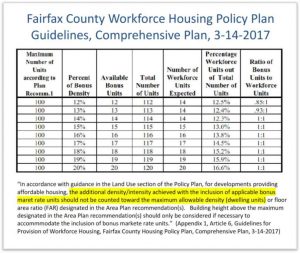 Second, an obscure passage in the PRC zoning ordinance discloses that the affordable housing itself does not count toward the population “cap” according to the PRC zoning ordinance (Article 6-308) and the County’s housing policy plan. The last paragraph on “maximum density” in the PRC ordinance ends with this: “(The preceding restrictions on density) shall not apply to affordable and market rate dwelling units which comprise the increased density pursuant to Part 8 of Article 2 (which sets standards for the Affordable Dwelling Unit Program) …” We welcome the housing diversity, but we think the people living in that 12.5 percent to 20 percent workforce housing should count and the infrastructure and amenities required for them should be in the County’s plans. That’s another potential 20 percent added to our total population.
Second, an obscure passage in the PRC zoning ordinance discloses that the affordable housing itself does not count toward the population “cap” according to the PRC zoning ordinance (Article 6-308) and the County’s housing policy plan. The last paragraph on “maximum density” in the PRC ordinance ends with this: “(The preceding restrictions on density) shall not apply to affordable and market rate dwelling units which comprise the increased density pursuant to Part 8 of Article 2 (which sets standards for the Affordable Dwelling Unit Program) …” We welcome the housing diversity, but we think the people living in that 12.5 percent to 20 percent workforce housing should count and the infrastructure and amenities required for them should be in the County’s plans. That’s another potential 20 percent added to our total population.
Between not counting workforce dwelling units and the bonus density they allow, the nominal 99,933 population cap under the County’s proposed 16 persons per acre in the Reston PRC potentially becomes 139,906 souls in the Reston PRC district, a nearly 40,000-person increase over the nominal cap and nearly 80,000 more people than live in all Reston now.
And then, third, there is the elephant in the room: The County’s current discussion about the Reston PRC change has excluded any reference to the Reston Master Plan’s potential development of 44,000 DUs in Reston’s transit station areas (Figure 35, p. 103), most of which is outside the PRC-zoned area. Based on a County count of existing, approved and planned PRC development in RTC (13,772 DUs — not counting affordable and bonus units?) detailed in Reston Now two weeks ago, we can assume as many as 20,000 DUs may be built in the PRC portion of Town Center over the next 40 years. That leaves 24,000 DUs — about 50,000 people — to be added elsewhere in Reston’s station areas. So add another 50,000 people to Reston’s population — not counting the workforce housing and bonus development that goes with it.
Deadline for RA Board Candidacy is Today — Anyone interested in being considered to fill the At-Large seat vacated by Ray Wedell needs to submit a statement of candidacy by noon today. The remaining term on the seat runs through April. [Reston Now]
Silver Line Was Single-Tracking This Morning — An arcing insulator at the Rosslyn Metro station early this morning caused single-tracking on the Orange, Silver and Blue lines. [WUSA]
‘Safety Stand-Down’ Slowed Metro Thursday — Riders experienced woes Thursday morning on the Metro as maintenance inspections of 7000-series rail cars were temporarily suspended, raising union concerns and leaded to fewer available cars. [WTOP]
Letter: Redistricting Needed After 2020 — John Lovaas, of Reston, says residents need to get involved in the fight to end gerrymandering and “take back our democracy.” [Fairfax Times]
Full Presentation from Wednesday’s Community Meeting — The full PowerPoint presentation from Wednesday’s forum to discuss the potential ramifications of a zoning ordinance amendment that would raise the cap on population density in Reston has been made available. [Reston 20/20]
A zoning ordinance amendment being suggested by Fairfax County could result in Reston’s population increasing threefold by 2050, community advocates say, and local residents are being encouraged to speak out against it.
Reston 20/20, Reclaim Reston and the Reston Citizens Association presented a community information session on the County’s proposal Wednesday, attended by more than 100 concerned Restonians. The goal of the event was to help residents learn more about what the amendment means and to prepare them for a fourth public meeting on the proposal, being presented by Supervisor Cathy Hudgins at 7 p.m. Monday at Lake Anne Elementary School (11510 North Shore Drive). The first three meetings on the proposal, held in May, were not seen as adequate by many Restonians who attended them.
“Community participation is vital and must be continuous,” said Dennis Hays, Reston Citizens Association president, during the presentation. “I don’t believe just sitting and having someone tell you what they’ve already decided is participation.”
The proposal from the county’s Department of Planning and Zoning would bump the overall limit on people per acre in Reston’s Planned Residential Community (PRC) District from 13 to 16. (The density is currently about 11.9 people per acre.) The PRC District does not include any of the Transit Station Area property surrounding the Wiehle-Reston East and Herndon Metro stations, nor does it include most of the property in the Reston Town Center Metro station TSA south of the Dulles Toll Road.
The ordinance amendment would also allow for the Board of Supervisors to be able to approve individual developments in excess of 50 dwelling units per acre in TSAs within the PRC and when in accordance with Comprehensive Plan recommendations. Those areas that would be marked for major residential development include all of Reston’s village centers.
If the zoning ordinance were to go into effect, Hays said, it would be akin to the genie being let out of the bottle for development all over Reston.
“Once it’s a zoning ordinance, it’s done; it’s over; there’s not much we can do, ever,” he said.
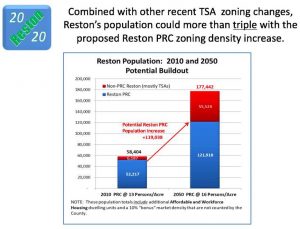 According to numbers presented by Terry Maynard, co-chair of Reston 20/20, the proposed changes combined with high-rise development in TSAs could result in Reston’s overall population increasing to more than 177,000 by 2050. John Mooney, representing Reclaim Reston, said that even by conservative estimates, this would increase peak-time traffic in the community by nearly double if infrastructure needs are not addressed concurrently.
According to numbers presented by Terry Maynard, co-chair of Reston 20/20, the proposed changes combined with high-rise development in TSAs could result in Reston’s overall population increasing to more than 177,000 by 2050. John Mooney, representing Reclaim Reston, said that even by conservative estimates, this would increase peak-time traffic in the community by nearly double if infrastructure needs are not addressed concurrently.
In addition to a lack of adequate streets to accommodate the increased population, Maynard said the lacking infrastructure would also include a deficit in schools and parks. Concerns about police staffing, fire coverage and more were also brought up by other residents.
“You don’t put that cart before the horse,” said Bruce Ramo, of Reclaim Reston, which has organized a petition effort in the attempt to get the county to stop new development proposals and zoning changes until infrastructure needs are addressed. “That’s why we’re saying what we’re saying here tonight: Let’s step back and do it right.”
PRC Zoning Ordinance Amendment Info Session Tonight — Reston 20/20, Reclaim Reston and the Reston Citizens Association will present the forum tonight from 7-9 p.m. at Reston Association headquarters (12001 Sunrise Valley Drive). This is being held in advance of the fourth public meeting on the proposal, being presented Monday by Supervisor Cathy Hudgins and County Planning and Zoning staff. [Reston Now]
Site Lists Top Places to Eat in Reston — Eater’s list includes 10 locations within Reston Town Center, but it also branches out to Lake Anne, South Lakes and more. [DC Eater]
Copperhead Spotted on W&OD Trail — The venomous snake was spotted last week on the trail near the Luck Stone Quarry overlook in Ashburn, serving as a reminder to be watchful when out in nature. [Loudoun Times-Mirror]
Dulles Day Festival is This Weekend — The 25th annual open house event at the airport Saturday will include a 5K/10K on runways, a festival on the airfield, and the plane-pull competition. [Dulles International Airport]
Another Brewery Coming to Route 28 Corridor — Rocket Frog Brewing Company is looking to open in Sterling early next year. This is on the heels of Ono Brewing Company opening recently in Chantilly. [The Burn]
File photo by Audrey Lawson
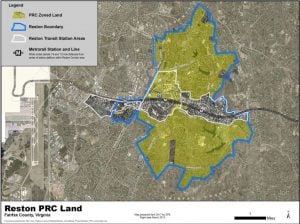 Three community advocacy organizations have combined efforts to plan an informational forum about Fairfax County’s proposed zoning ordinance amendment that would increase the density cap in Reston’s Planned Residential Community (PRC) district.
Three community advocacy organizations have combined efforts to plan an informational forum about Fairfax County’s proposed zoning ordinance amendment that would increase the density cap in Reston’s Planned Residential Community (PRC) district.
Reston 20/20, Reclaim Reston and the Reston Citizens Association will present the forum Wednesday, Sept. 20, from 7-9 p.m. at Reston Association headquarters (12001 Sunrise Valley Drive). This is being held in advance of the fourth public meeting on the proposal, being presented by Supervisor Cathy Hudgins at 7 p.m. Monday, Sept. 25 at Lake Anne Elementary School (11510 North Shore Drive).
The proposal from the county’s Department of Planning and Zoning would bump the overall limit on people per acre in Reston’s PRC from 13 to 16. (The density is currently about 11.9 people per acre. The ordinance amendment would also allow for the Board of Supervisors to be able to approve individual developments in excess of 50 dwelling units per acre in TSAs within the PRC and when in accordance with Comprehensive Plan recommendations.
“We will share with you why these changes are being proposed and the impact on our open space, traffic, schools and other public facilities. We invite you to ask questions, and share your views and concerns,” reads an invitation being distributed for the forum. “Let’s come together to ensure we can continue to say ‘Reston is a planned community,’ and NOT ‘Reston was a planned community.'”
Information was first shared by the county with the community in three public meetings in May. At May’s meetings, residents expressed their concern that the county was trying to rush the amendment through the approval process. They were especially upset when the third meeting was held in an open-house format rather than as a question-and-answer session.
The DPZ had originally hoped to bring the plan before the Board of Supervisors in July, followed by a Planning Commission public hearing in September and the Board public hearing in October. It now has those projected dates pushed back to November, December and January, respectively.
For more information about the Sept. 20 informational meeting, contact members of Reston 20/20, Reclaim Reston and/or the Reston Citizens Association.
Reston 20/20 Slams Fairfax County — In a detailed report examining Fairfax County’s proposal to allow a substantial increase in population density in Reston’s Planned Residential Community (PRC) zoning area, the Reston 20/20 Committee critiques the County’s motivation for the accelerated passage of the amendment. [Reston 20/20]
FCPS Free Lunch Program Underway — The Food for Every Child to Eat During Summer (FEEDS) program provides picnic-style summer lunches each day from 11:30 a.m. to 1 p.m. for all. Locally, they are available at Dogwood Elementary School (12300 Glade Drive). [Fairfax County Public Schools]
91 Metro Stations, 91 Songs — An Alexandria man has worked for over six years to compile a series of songs about the stops on the Metro. His completed work, which includes a song about Wiehle-Reston East, spans eight albums. [Washington Post]
 This is an op/ed submitted by Terry Maynard, co-chair of the Reston 20/20 committee. It does not reflect the opinions of Reston Now.
This is an op/ed submitted by Terry Maynard, co-chair of the Reston 20/20 committee. It does not reflect the opinions of Reston Now.
Reston’s population is a key factor in the County’s high-speed drive to raise the density limits in our Planned Residential Community (PRC) zoning ordinance from 13 to 16 persons per acre across Reston to accommodate growth laid out in the new Reston Master Plan. It argues that Reston is at 12 persons per acre right now, including existing and approved development and we need to create more headroom for growth. Specifically, its “calculated estimate” of Reston PRC population, including approved plans but excluding affordable dwelling units, is 74,192 people.
Not even close on Reston’s current population — including the non-PRC areas of Reston.
The Past
The County was even badly wrong back in 2006 when it adjusted the zoning ordinance household factors — the average number of people living in each type of housing (single-family, townhomes, multi-family — garden and elevator). At that time it put Reston’s “calculated” PRC population at 64,227, roughly 10,000 fewer people than it calculates today.
Then reality set in.
In 2010, the US Census put Reston’s population at 58,404 in 25,304 occupied dwelling units, including such non-PRC areas as Deepwood and much of the Reston station area corridor. That’s a population density of 9.4 persons per acre of Reston PRC, nearly 40 percent below the current density limit of 13 persons per acre –hardly a driver for raising the overall population density ceiling.
The Present
The American Community Survey, the US Census’ official mid-decade estimate of population and other data, then put Reston’s population at 60,112 in 2015. Other unofficial sources tend to have even lower estimates of Reston’s population.
So why is the County claiming the much larger “population calculation” of 74,192 people in the PRC, which is most, but not all, of Reston?
The key reason is that the County includes the population of developments that have been approved, but not yet built. In fact, many approved proposals have been on the books for a decade or more, including Colts Neck independent living (former Hunters Woods United Christian Parish now under construction), Reston Excelsior Oracle and Boston Properties Property #16 (under construction).
Spectrum Center is a major example. The Board gave final approval to this redevelopment in January 2013, but the developer — Lerner Enterprises — said then that redevelopment may not take place for many years, even decades. Indeed, the strip mall from Staples to Not Your Average Joe’s is still operating at capacity. Among other features, the redeveloped Spectrum Center is approved to include more than 1,400 dwelling units (almost 3,000 people).
Community group Reston 20/20 is calling for an independent committee of RA members to be formed to delve deeper into the circumstances surround Reston Association’s controversial Tetra/Lake House deal.
The group made the recommendation Monday as part of a 10-page analysis of StoneTurn Group’s review of the transaction and subsequent cost overrun, which was completed in February.
According to Reston 20/20’s recommendation, the committee should be formed after the board’s elections have completed in April. At that time, four new members will join the nine-person board.
“In light of the fact that the current Board majority was immersed in all the events described here and in StoneTurn’s report, it has no credibility in conducting any further actions on Tetra,” said Terry Maynard, co-chair of Reston 20/20. “The new RA Board, installed next month with a majority not involved in Tetra, should tackle the issues we raise here and any others it finds in a deep dive effort by a committee of Restonians.”
The majority of which Maynard speaks will be made up of the four new members plus director Sherri Hebert (Lake Anne/Tall Oaks District) who was elected in 2016, following the conclusion of the transaction and renovations. Hebert has also recently called for more community involvement in the analysis of the report. (Two other continuing board members, Julie Bitzer and Ray Wedell, were elected in April 2015 — after the purchase proposal had been drawn up and scheduled for referendum, which passed with 53 percent of the vote in May 2015.)
In its analysis, Reston 20/20 says StoneTurn’s report provides “important new information on the timeline of actions leading to the excessive price paid for the property and its huge repair costs,” which it says is “a vital first step in understanding fully what transpired in this unfortunate venture for RA and its members.” The analysis goes on to ask numerous followup questions, many related to personal responsibility for decisions made during the process, including:
- “Did RA agree on the price prior to Board approval in January 2015? If so, why? Who made that decision and why?”
- “Who altered the appraisal instructions to assume Tetra was in good repair and the hypothetical restaurant use was large and extended into the lake?”
- “Why wasn’t conflict of interest specifically discussed in the StoneTurn report?”
Reston 20/20 says it wants the citizens’ committee to have “unlimited access to all RA records relating to Tetra; the authority to interview RA employees, contractors and others with possible knowledge about Tetra; and the authority to request records from contractors who worked [with] RA on the Tetra purchase and renovation.”
A group of Reston Association members, working under the name Mediaworld Ventures LLC, had been selected in September 2016 by the Board of Directors to complete a review of the purchase and cost overrun at a cost of $1. The parties could not agree on the terms of a contract, however, and negotiations were terminated in January. The board agreed later that month to have StoneTurn complete the review at a cost of $45,000.
StoneTurn’s review provided 15 recommendations to the RA board for how to avoid a similar situation from happening in the future. Reston 20/20 members say without rooting out more specifics of the transaction, changes to procedure may have minimal effect.
“We believe it is vital to understand the full details of what transpired, including identifying any violations of policy, procedure or the law and the persons involved in those activities. If we do not dig out these details, RA runs a serious risk of repeating many of the same errors in the future no matter what process changes are added.”
The RA Board of Directors has a special meeting scheduled for Tuesday at 6:30 p.m. (weather-permitting) to discuss the results of StoneTurn’s report and the recommendations for the board that were provided within.
 This is an op-ed submitted by Terry Maynard, co-chair of the Reston 20/20 committee. It does not reflect the opinions of Reston Now.
This is an op-ed submitted by Terry Maynard, co-chair of the Reston 20/20 committee. It does not reflect the opinions of Reston Now.
Two years ago this month, under the leadership of former RA Board President Ken Kneuven, Reston’s homeowner association announced its deal with a local developer to purchase his property, the Tetra office building, for over twice its county-appraised value of $1.2 million. Thus began a long slide of Reston Association into bad governance and mismanagement.
How did this happen? We don’t know for sure, but we understand Kneuven and another former RA Board President, Rick Beyer, who lives on the shore of Lake Newport opposite the Tetra property, have been friends for some time. Beyer, who was active in supporting the RA Tetra purchase, and other Lake Newport homeowners were no doubt concerned that something untoward would happen to their view and, as a result, also their property values. It is not clear whether Beyer asked a favor from Kneuven in eliminating this risk by having RA pursue the purchase of the Tetra property, but what is clear is that after Kneuven left his RA post, he ended up working as a senior consultant in the company managed by Beyer.
As for the rest of us, RA and its Board justified paying $2.65 million in part by pointing out that a proposal had been drawn up to build a costly restaurant there twice the size of the Tetra building. RA didn’t bother to note, however, that the restaurant was never approved, nor would it have been given environmental restrictions and 14 easements on the property. Moreover, RA’s appraiser put the property’s “as is” value at just $1.1 million using the Income Approach, even lower than the county’s valuation. In fact, the Tetra property had been on and off the market with little interest for most of a decade.
Nonetheless, to sell the deal in a community referendum, RA “projected” that renovations, inside and out, would cost RA members just $259,000. To date, interior repairs alone have cost Restonians $692,000 — not counting $925,000 in seller contributions and a Comstock proffer to RA which could have been used for much better purposes — and an RA consultant projects proposed exterior improvements will cost $1.2 million.
On the other side of the ledger, RA projected rental income from a rent back agreement with the Tetra owners of more than $140,000 through 2016. Unfortunately, the sloppily written agreement allowed Tetra’s former owners to walk away at the end of 2015, resulting in an immediate $100,000 loss in RA revenues. RA scrambled to make up the shortfall, but — as of November — expected year-end cash flow losses reached $902,000, some $515,000 more than RA projected for 2016 during the Tetra referendum.
If publicly known at the time, these massive misstatements, mistakes, expenses and overruns would have doomed the purchase’s narrow community approval.
Indeed, the massive renovation cost overruns were not revealed until May 2016, although RA financial data indicated RA and presumably some Board members knew there would be huge overruns as early as February. Thus, RA members were denied that important information as they cast their ballots for RA Board members in February, including the re-election runs of two Board members who strongly supported the Tetra initiative, Eve Thompson and Danielle LaRosa. Of course, they won re-election in the absence of public knowledge of the huge cost overrun.
When the cost overruns were disclosed, even the complicit RA Board found this revealed reality a bit much. Under significant community pressure, it agreed last summer to contract for an independent review of the purchase and renovation.
After choosing to sign a pro bono $1 review contract with Mediaworld LLC, using a team of Reston volunteers expert in financial matters, a few members of the Board sabotaged its own by insisting on excessive RA control and contractor liability in multiple, lengthy contract drafts. A special Board meeting with the Mediaworld volunteers in December couldn’t salvage the negotiations — another obstructionist draft resulted — and the volunteers withdrew last week, explaining the multitude of reasons why.
The increasingly urgent question is: What are some members of RA’s Board and senior staff trying to conceal about the Tetra acquisition and renovation — and why? Did they engage in illegal, unethical or just plain stupid behavior? Unless there is a criminal investigation, the chances are dwindling Restonians will ever know who, how, why and when all this financial mischief occurred as the Board and staff continue to hide the truth any way they can. The future of honest, open, prudent governance in Reston has never looked more uncertain.
The RA Board 2017 election a month away is an opportunity to reverse the Board’s recent gross misbehavior. There are four openings and, if filled with candidates who seek to reform the RA Board and the way it does business, the Board could actually represent the interests of the community rather than the guilty. Pay attention to what candidates file and what they say about the handling of Tetra, including the need for an audit, the development of an RA ethics policy with teeth and openness in RA decision making. It could be your last chance in years for meaningful change in how our community is governed.
Terry Maynard, Co-Chair
Reston 20/20 Committee


